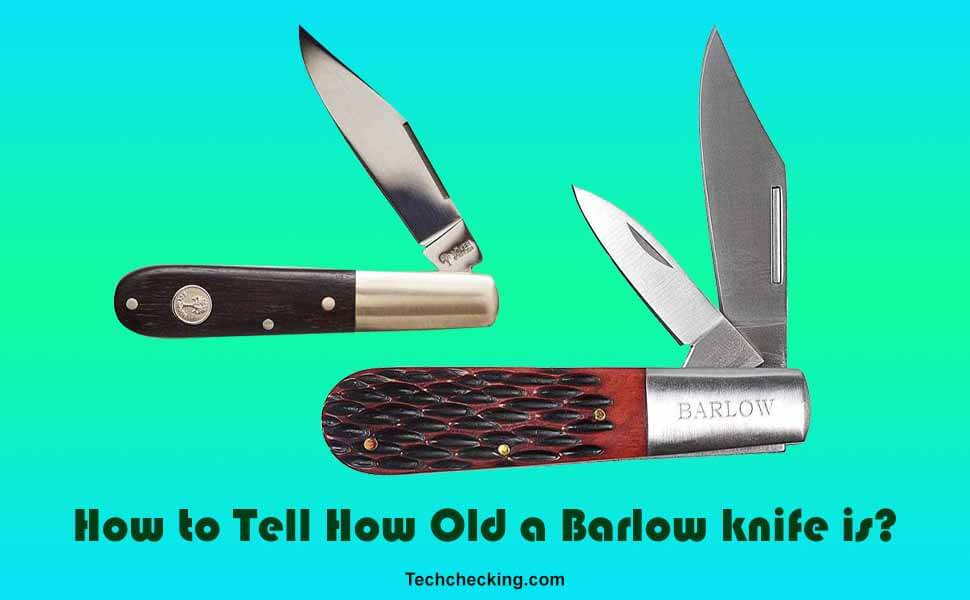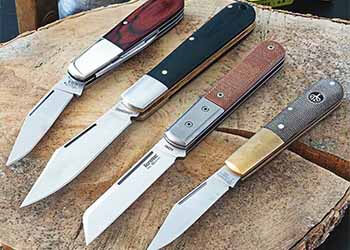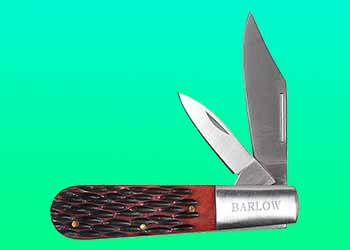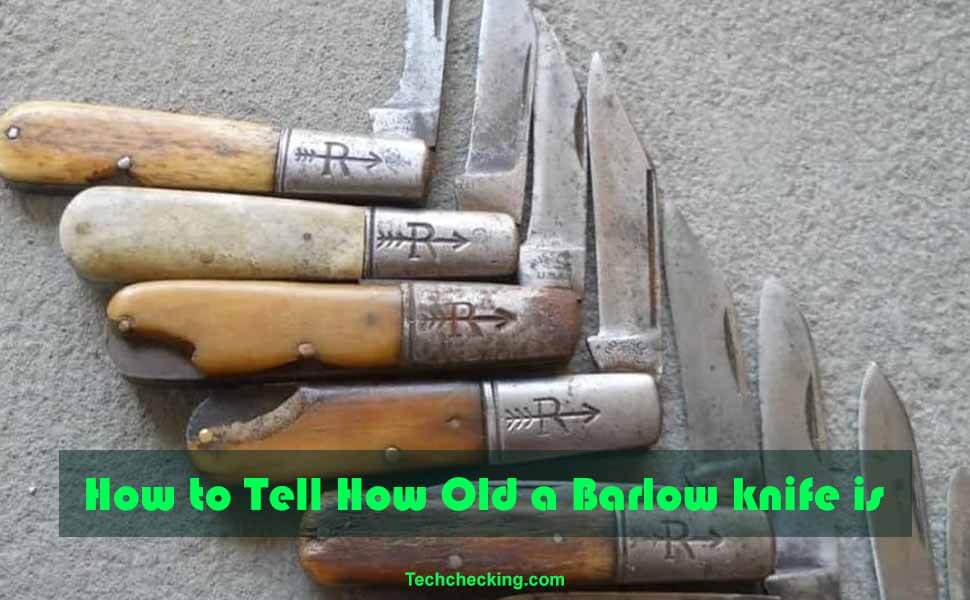If you own a Barlow knife and are curious about its age, you’re not alone. Learning how to tell how old a Barlow knife is can be a fascinating endeavor, especially if you’re a collector or simply have an appreciation for antique or vintage knives. Barlow knives have a rich history, and each era has distinct characteristics that can help you identify its age. With a little research and attention to detail, you can uncover the age of your Barlow knife and gain a better understanding of its value and significance. In this article, we’ll guide you through the process of determining the age of your Barlow knife, providing you with the knowledge and tools you need to make an informed assessment. So, let’s get started on exploring how to tell how old a Barlow knife is!
Related Articles:
How to Tell How Old a Barlow knife is
History of the Barlow knife

The Barlow knife has a fascinating history that stretches back over 400 years. The original Barlow knife was created by Obadiah Barlow in Sheffield, England, in the early 1600s. Barlow designed the knife to be a rugged and practical tool for farmers and laborers, with a simple and sturdy design that made it both affordable and reliable. The Barlow knife quickly gained popularity in America during the 18th and 19th centuries, where it was used for a wide range of tasks, from cutting rope to whittling.
Over time, the Barlow knife continued to evolve, with various manufacturers experimenting with different materials and designs. In the 1800s, the Barlow Knife Company was founded in the United States, and it quickly became one of the most prominent knife manufacturers in the country. Today, Barlow knives are still produced by a number of companies and are highly prized by collectors for their history and craftsmanship. Whether you’re a collector or simply appreciate a well-made knife, the Barlow knife history is a fascinating journey through centuries of craftsmanship and innovation.
Importance of Identifying the Age of a Barlow knife

Identifying the age of a Barlow knife is crucial for a number of reasons, especially for collectors and enthusiasts. Knowing the age of a Barlow knife can help you determine its rarity and value. Older Barlow knives are typically more valuable than newer ones because they are harder to come by and have a certain historical significance.
Additionally, identifying the age of a Barlow knife can provide important information about its history and provenance. It can also help you determine whether the knife is an original Barlow knife or a reproduction. This information is essential for collectors who are interested in building a collection of genuine Barlow knives.
Moreover, understanding the age of a Barlow knife can help you determine how to care for it properly. Different eras of Barlow knives may have different materials and construction techniques, and understanding these differences can help you preserve the knife and prevent damage.
In short, identifying the age of a Barlow knife can enhance your appreciation and understanding of these historic knives, and it can also help you make informed decisions about buying, selling, or trading Barlow knives.
Factors that Affect the Value of Barlow Knives

Several factors influence the value of Barlow knives. Some of the key factors that affect the value of these knives include:
- Age: The age of a Barlow knife is a crucial factor that determines its value. Older Barlow knives are typically more valuable than newer ones because they are harder to find and have a certain historical significance.
- Rarity: The rarity of a Barlow knife can significantly impact its value. If a particular Barlow knife is rare or hard to find, it can command a much higher price than a more common model.
- Condition: The condition of a Barlow knife is another critical factor that affects its value. Knives that are in excellent condition, with minimal wear and tear, will typically command a higher price than knives that are damaged or heavily used.
- Brand: The brand of the Barlow knife is also an essential factor in determining its value. Original Barlow knives made by reputable manufacturers such as George Wostenholm & Son, Case Knives, and Schrade are generally more valuable than knives made by lesser-known brands.
- Materials: The materials used to make a Barlow knife can also impact its value. Knives made with high-quality materials like bone, horn, and exotic woods, will typically command a higher price than knives made with cheaper materials like plastic.
- Historical Significance: Finally, the historical significance of a Barlow knife can also impact its value. For example, if a particular Barlow knife was owned by a famous person or has a unique history, it can command a higher price than other knives of its kind.
Barlow knife has a great value if you can recognize it. Any antic will have significance if the mentioned factors are conspicuous. Let’s now know the identifying factors of a Barlow knife if it is an antic.
Identifying Characteristics of Barlow Knives
Barlow knives have distinct identifying characteristics that make them stand out from other types of knives. Here are some of the most prominent characteristics to look for when identifying a Barlow knife:
- Handle: Barlow knives typically have a handle with a distinct elongated teardrop shape that narrows toward the blade. The handle is usually made of bone, wood, or other natural materials, and it may be adorned with decorative accents such as bolsters, inlays, or engravings.
- Blade: The blade of a Barlow knife is usually made of high-quality stainless steel or carbon steel. It is typically a clip-point or spear-point blade, and it may be plain or serrated. The blade of a Barlow knife is usually long and narrow, with a slight curve toward the point.
- Size: Barlow knives come in a range of sizes, but they typically fall into the medium-to-large category. The blade length is usually between 2.5 and 3.5 inches, and the overall length of the knife is usually between 6 and 8 inches.
- Bolsters: Barlow knives usually have bolsters on both ends of the handle. These are typically made of brass or nickel silver, and they add an extra layer of protection to the handle. The bolsters may be plain or decorated with engravings or other accents.
- Shield: Many Barlow knives have a shield on one side of the handle. The shield is usually made of brass or nickel silver, and it may be engraved with a logo or other design.
- Folding mechanism: Barlow knives are typically folding knives with a slip joint mechanism. The blade is held in place by a spring, and it can be opened and closed with one hand.
By examining these identifying characteristics, it is usually possible to identify a Barlow knife and distinguish it from other types of knives.
How to Identify the Age of a Barlow Knife

If you are a collector or enthusiast of Barlow knives, one important skill to have is the ability to identify the age of a knife. There are several factors to consider when trying to determine the age of a Barlow knife, including its stampings and engravings, handle materials, and blade design. Here are some guidelines to help you identify the age of a Barlow knife:
- Look for manufacturers’ markings: Check the blade for the manufacturer’s name, model number, and date of production. These markings can help you determine the age of the knife.
- Examine the tang stamp: The tang stamp is a small marking located on the blade near the handle. The style and wording of the tang stamp can provide valuable information about the age of the knife.
- Check for blade etchings: Some Barlow knives have etchings on the blade that can provide clues to the age of the knife. Look for any patterns, designs, or wording that may be unique to a particular time period.
- Consider the handle materials: The type of handle material used can give you an indication of the age of the knife. For example, older knives may have handles made of materials such as bone, ivory, or tortoise shell, while newer knives may have handles made of synthetic materials.
- Look for signs of aging on natural handle materials: If the knife has a handle made of natural materials such as wood or bone, look for signs of aging such as discoloration or cracking. These signs can help you determine the age of the knife.
- Examine the blade design: Barlow knives have gone through several design changes over the years. Look for details such as the shape and length of the blade, the number of blades, and any unique design features that can help you identify the age of the knife.
By considering these factors, you can develop a better understanding of the age and value of a Barlow knife. With some practice, you can become an expert at identifying the age of these popular and historic knives. By knowing how to tell how old a Barlow knife is without a serial number, you can accurately determine its age and value.
Tools and Techniques for Identifying Age
When it comes to identifying the age of a Barlow knife, there are several tools and techniques that can be used. Here are a few:
- Magnifying Glass: Using a magnifying glass can help you examine the blade markings and tang stamp, which can provide valuable information about the age and manufacturer of the knife.
- Reference Books: There are several reference books available that provide detailed information about the history and production of Barlow knives. These books can be a valuable resource when trying to identify the age of a knife.
- Online Forums: There are several online forums dedicated to Barlow knives, where collectors and enthusiasts share information and expertise. These forums can be a great place to ask questions and learn more about the history and identification of Barlow knives.
- Expert Appraisal: If you’re having difficulty identifying the age of a Barlow knife, you may want to consider having it appraised by an expert. A professional appraiser can provide a detailed analysis of the knife’s age, condition, and value.
By using these tools and techniques, you can accurately identify the age of a Barlow knife and gain a deeper understanding of its history and value.
Care and Maintenance of Barlow Knives

Proper care and maintenance of your Barlow knife can help extend its lifespan and ensure that it functions properly. Here are some tips for caring for and maintaining your Barlow knife:
- Clean your Barlow knife regularly: After each use, it is important to clean your Barlow knife thoroughly. Use a soft cloth or paper towel to wipe the blade and handle clean. Avoid using water, as it can cause rusting and damage the handle material.
- Keep your Barlow knife dry: Always keep your Barlow knife dry, especially if it has a wooden or bone handle. Moisture can cause the handle to crack or warp over time.
- Store your Barlow knife properly: When not in use, store your Barlow knife in a dry, cool place. Avoid storing it in a leather sheath for extended periods, as this can cause the blade to rust.
- Sharpen your Barlow knife regularly: A dull blade can be dangerous and ineffective. Use a sharpening stone or honing rod to sharpen your Barlow knife regularly, following the manufacturer’s instructions.
- Oil your Barlow knife: Applying a light coat of oil to your Barlow knife can help protect the blade from rust and corrosion. Use a high-quality oil designed specifically for knives.
- Avoid using your Barlow knife for unintended purposes: Barlow knives are designed for specific purposes, such as cutting, slicing, and carving. Avoid using your knife for unintended purposes, such as prying or digging, as this can damage the blade and handle.
By following these simple tips, you can keep your Barlow knife in top condition and enjoy its use for many years to come.
Frequently Asked Questions
Q: What is a Barlow knife?
A: A Barlow knife is a type of folding pocket knife with two blades and a distinctive elongated oval handle.
Q: How long have Barlow knives been around?
A: The exact date of the Barlow knife’s production is unclear, but it is believed to have been introduced in the late 1700s or early 1800s. So it can be told, the Barlow knives have been around since the 18th century.
Q: What are the different eras of Barlow knives?
A: The different eras of Barlow knives include the early era, the transitional era, and the modern era.
Q: What are the distinguishing features of a Barlow knife?
A: Distinguishing features of a Barlow knife include a long oval handle, a large bolster, and a single or double blade.
Q: How can I tell the age of my Barlow knife?
A: You can tell the age of your Barlow knife by examining its blade design, handle materials, and markings or engravings.
Q: What are some identifying characteristics of antique Barlow knives?
A: Some identifying characteristics of antique Barlow knives include bone or wooden handles and unique engravings.
Q: How do I differentiate between a vintage and modern Barlow knife?
A: Vintage Barlow knives may have different blade designs and materials than modern ones.
Q: How do I identify the age of a Barlow knife?
A: The age of a Barlow knife can be identified through various characteristics such as blade design, handle material, and stampings or engravings.
Q: What are the different types of Barlow knives?
A: The different types of Barlow knives include traditional Barlow knives, collector’s editions, and modern adaptations.
Q: What tools or resources do I need to determine the age of my Barlow knife?
A: To determine the age of your Barlow knife, you may need tools like a magnifying glass or a reference book.
Q: Are there any markings or symbols on Barlow knives that can help determine age?
A: Markings or symbols on Barlow knives, such as manufacturer stamps or unique engravings, can help determine their age.
Q: What is the value of an antique or vintage Barlow knife?
A: The value of an antique or vintage Barlow knife depends on factors such as its age, rarity, and condition.
Q: Are Barlow knives still being produced today?
A: Yes, Barlow knives are still being produced today by various knife manufacturers.
Q: Where can I purchase a Barlow knife?
A: Barlow knives can be purchased from knife shops, online retailers, or antique dealers.
Q: How can I properly care for my Barlow knife?
A: Proper care for a Barlow knife includes cleaning, lubricating, and storing it in a dry place.
Final Words
In conclusion, identifying the age of a Barlow knife is an important aspect for collectors and enthusiasts. While there are no foolproof methods for determining the age of a Barlow knife, a combination of techniques such as examining the blade design, handle materials, stampings and engravings, and using online resources can provide valuable information. Additionally, understanding the different eras and production periods of Barlow knives can aid in narrowing down the possible age of a knife. Properly identifying the age of a Barlow knife can add value to a collection and provide a deeper appreciation for the rich history and craftsmanship of these iconic knives.
Image Credit:

